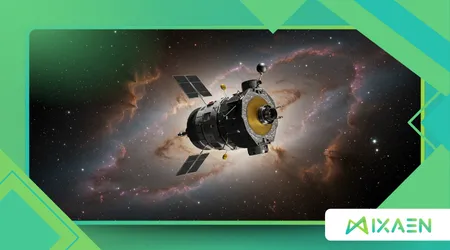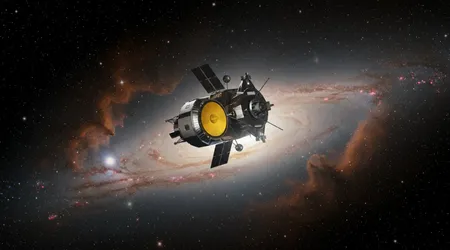The Legacy of Voyager: Humanity’s Most Distant Message

The legacy of Voyager resonates as one of humanity’s boldest steps into the cosmos, a testament to our curiosity and ambition.
Anúncios
Launched in 1977, NASA’s Voyager 1 and 2 probes have journeyed beyond our solar system, carrying messages for potential extraterrestrial civilizations.
These spacecraft, now over 15 billion miles from Earth, embody our drive to explore the unknown. This article delves into the legacy of Voyager, exploring its scientific triumphs, cultural significance, and enduring inspiration.
Why do these aging probes still captivate us in 2025? Their story intertwines human ingenuity, cosmic wonder, and a timeless quest for connection.
The Voyager program began during a rare planetary alignment, allowing the probes to visit Jupiter, Saturn, Uranus, and Neptune.
Their discoveries reshaped planetary science, while the Golden Record a time capsule of Earth’s sounds, images, and greetings extends humanity’s voice into the stars.
As we navigate 2025, with new missions like Europa Clipper and private space ventures, the legacy of Voyager remains a benchmark for exploration.
This piece will unpack its impact through science, culture, and future inspiration, weaving a narrative that’s both reflective and forward-looking.
A Scientific Odyssey Beyond the Solar System
The Voyager probes redefined our understanding of the outer planets. Voyager 1’s 1979 Jupiter flyby revealed Io’s active volcanoes, a stunning surprise.
Voyager 2, the only spacecraft to visit Uranus and Neptune, unveiled their complex atmospheres and moons.
These findings, still foundational in 2025, guide missions like those to Europa. The probes’ data, transmitted over 23 hours from interstellar space, continue to inform heliophysics.
Beyond planetary exploration, the legacy of Voyager lies in its interstellar mission. Voyager 1 crossed the heliopause in 2012, entering interstellar space, followed by Voyager 2 in 2018.
Their instruments measure cosmic rays and plasma, offering unique data no other mission can replicate. For example, Voyager 2’s 2018 data confirmed a “hydrogen wall” at the solar system’s edge, a discovery validated by New Horizons.
++ How Cold War Tensions Shaped the Race to the Moo
Despite aging systems, engineers at NASA’s Jet Propulsion Laboratory (JPL) keep the probes operational. In 2025, power management extends their life, with Voyager 1’s thrusters revived after decades.
This resilience mirrors a marathon runner pacing for the long haul, ensuring data collection into the 2030s. The legacy of Voyager thus endures in its scientific tenacity.
The probes’ instruments, though limited, remain vital. Voyager 1 operates four tools, while Voyager 2 runs five, including magnetometers and plasma wave detectors.
These provide real-time insights into interstellar conditions, shaping our cosmic perspective. Their data, though sparse, is a lifeline to the unknown, guiding future missions.

The Golden Record: A Cosmic Time Capsule
Imagine a phonograph record carrying Earth’s essence to the stars. The Golden Record, aboard both Voyagers, does just that.
Curated by Carl Sagan’s team, it holds 116 images, 55 greetings, and sounds from whale songs to Mozart. This artifact, a snapshot of 1977 Earth, is humanity’s interstellar postcard.
The legacy of Voyager shines through this cultural endeavor. The record’s greetings in languages like Akkadian and Amoy reflect our diversity.
Its music, from Beethoven to Chuck Berry, captures our creativity. In 2025, as we ponder extraterrestrial life, the record remains a bold gesture of outreach.
Also read: SpaceX vs. NASA: A New Era or a Dangerous Privatization?
Crafting the Golden Record was a feat of vision. Selecting content to represent humanity required balancing science, art, and culture.
The inclusion of a child’s greeting or a mother’s lullaby humanizes the project, making it relatable across generations. It’s a message not just for aliens but for us, reflecting our shared identity.
The record’s durability is remarkable. Designed to last a billion years, it could outlive Earth’s civilizations.
Floating through the cosmos, it carries our story, a whisper of humanity’s existence. This enduring symbol of hope and curiosity elevates the legacy of Voyager to a cultural milestone.
Engineering Marvels and Human Resilience
The Voyagers’ longevity is a triumph of engineering. Powered by plutonium-238 radioisotope thermoelectric generators (RTGs), they generate 470 watts at launch, now down to about 200 watts in 2025.
Engineers manage this decline by selectively shutting off systems, like Voyager 1’s cosmic ray subsystem in February 2025.
Maintaining contact with probes 15 billion miles away is no small feat. The Deep Space Network (DSN) sends commands via 70-meter antennas, with signals taking over 23 hours one way.
Read more: Could Ancient Civilizations Have Dreamed of Space Travel?
In 2025, upgrades to DSN’s Canberra antenna posed risks, yet engineers revived Voyager 1’s backup thrusters, a “miracle save.”
This ingenuity mirrors a chess grandmaster adapting to an opponent’s unexpected move. Engineers’ creative problem-solving, like adjusting thruster software to reduce clogging, extends the mission.
The legacy of Voyager thus includes human resilience, pushing technology beyond its limits.
The probes’ autonomy is equally impressive. Seven fault-protection routines allow them to self-correct, crucial given communication delays.
This foresight, built in the 1970s, ensures their survival in 2025’s harsh interstellar environment, a testament to NASA’s forward-thinking design.
Cultural Impact and Inspiration for the Future
The Voyagers have transcended science, becoming cultural icons. The “Pale Blue Dot” image, captured by Voyager 1 in 1990, shows Earth as a speck in space.
Carl Sagan’s reflection on this image humanity’s fragility in the “vast cosmic arena” resonates in 2025’s climate-conscious world.
Beyond imagery, the legacy of Voyager inspires art, music, and literature. Films like Star Trek: The Motion Picture draw from its mystique, while artists create works celebrating its journey. In classrooms, Voyager’s story sparks STEM interest, nurturing future explorers.
The probes’ influence extends to modern missions. Technologies like Voyager’s signal-coding systems shaped cell phones and CDs.
In 2025, as SpaceX and Blue Origin push boundaries, Voyager’s data informs their designs, proving its relevance. The probes’ story is a beacon for innovation.
Public fascination persists, evident in social media posts celebrating Voyager’s milestones.
A July 2025 post noted Voyager 1’s 15-billion-mile mark, calling it “humanity’s farthest ambassador.” This enduring awe underscores how the legacy of Voyager continues to unite and inspire.
Table: Key Milestones of the Voyager Program
| Year | Event | Details |
|---|---|---|
| 1977 | Launch | Voyager 1 and 2 launched in August and September. |
| 1979 | Jupiter Flyby | Voyager 1 discovers Io’s volcanoes; Voyager 2 follows. |
| 1980-81 | Saturn Flyby | Voyager 1 studies Titan; Voyager 2 explores rings. |
| 1986 | Uranus Flyby | Voyager 2 discovers 11 moons, studies atmosphere. |
| 1989 | Neptune Flyby | Voyager 2 reveals Great Dark Spot, Triton’s geysers. |
| 2012 | Interstellar Space | Voyager 1 crosses heliopause, first human-made object to do so. |
| 2018 | Interstellar Space | Voyager 2 enters interstellar medium, confirms hydrogen wall. |
| 2025 | Ongoing Operations | Engineers revive thrusters, extend mission life. |
Voyager’s Role in Shaping Space Policy
The Voyagers’ success has influenced space exploration policy. Their planetary flybys, costing $865 million, delivered unmatched data, setting a high bar for cost-effective missions.
In 2025, NASA’s budget debates often reference Voyager’s efficiency, advocating for sustained funding.
Their interstellar data informs policy on deep-space missions. The 2018 confirmation of a “hydrogen wall” by Voyager 2 shaped discussions on heliospheric boundaries, guiding future probes. Policymakers use this to justify investments in missions like the proposed Interstellar Probe.
Voyager’s global collaboration, involving scientists from multiple nations, set a precedent for international partnerships.
In 2025, joint missions like NASA-ISRO’s NISAR reflect this legacy, fostering cooperation. The probes’ story underscores the value of shared scientific goals.
The legacy of Voyager also raises ethical questions. Should we broadcast our presence via the Golden Record?
This debate influences 2025’s astrobiology policies, balancing exploration with caution about extraterrestrial contact, ensuring thoughtful future missions.
Frequently Asked Questions
What is the Golden Record, and why is it significant?
The Golden Record is a phonograph record on both Voyager probes, containing Earth’s sounds, images, and greetings. It symbolizes humanity’s hope to connect with extraterrestrial life, encapsulating our cultural diversity.
How long will the Voyager probes continue to operate?
With power management, NASA expects at least one instrument to function into the 2030s, though diminishing RTG power may end operations by 2030.
Can the Voyagers still take images?
No, their cameras were turned off in 1990 to save power. Even if active, the dark interstellar space would yield little to photograph.
Example 1: A Student’s Inspiration
In 2025, a high schooler in Chicago, inspired by Voyager’s “Pale Blue Dot,” launched a science fair project modeling heliospheric boundaries, winning national recognition.
Example 2: A Musician’s Tribute
A 2024 album by composer Elena Ruiz, Interstellar Echoes, uses Voyager’s plasma wave data to create ambient tracks, blending science and art.
Statistic: Voyager 1 is 15.5 billion miles from Earth as of May 2025, the farthest human-made object.
Analogy: The Voyager probes are like messages in bottles cast into the cosmic ocean, carrying humanity’s story to unknown shores.
This exploration of the legacy of Voyager reveals a saga of science, culture, and human spirit.
As we stand in 2025, these probes remind us to keep reaching, questioning, and dreaming across the stars.
